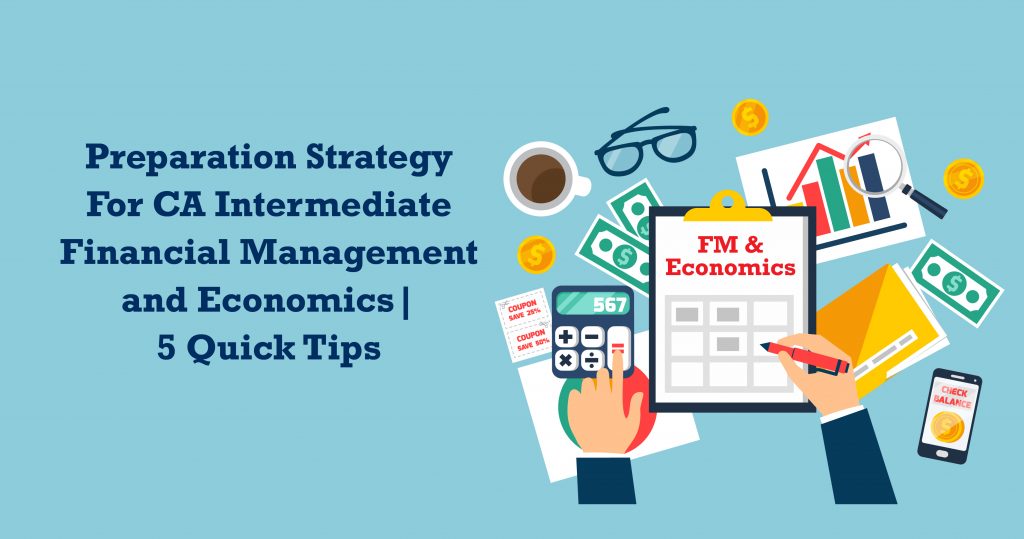COD Available NOW!
Preparation Strategy for CA Intermediate Economics for Finance | 5 Quick Tips
Preparation Strategy for CA Intermediate Economics for Finance | 5 Quick Tips

"Don't study hard, instead study Smart!"
You must have heard this quite often, isn't it? It applies to your CA Intermediate preparation too! You need to strategize properly and study smart.
When it comes to Paper 8 of CA Inter-Economics for Finance, students usually tend to focus extensively on Section A, Financial Management (FM) which carries a weightage of 60 marks. In the bargain, they are left with too little time to prepare for Section B i.e. Economics for Finance with a weightage of 40 marks.
Well, now if we leave aside the Financial Management part and solely focus on the Economics section, then proper and focused planning can turn to your advantage
So, let's have a quick sneak into the top 5 tactics that can aid you to bag the remaining 40 marks in Section B of CA Inter-Economics for Finance.
How to strategize your studies for Economics for Finance?
1. PREPARATION FROM BEGINNING

You need to start studying this subject well in advance. If at all you decide to do it at the end of the preparation schedule, you are surely going to run out of time.
2. ALLOCATE UNIT-WISE TIME

Out of 14 units in the syllabus, not all require equal study time. The ones with complex concepts, theories, formulae or diagrams require more time. So, you need to decide the study time to be allocated to each unit.
For example, suppose we are taking Chapter 2: Unit I - 'Fiscal Functions'. This unit would hardly take 1 or 2 hours approximately since it is smaller and simpler to understand. On the other hand, Unit II - 'Market Failure' from the same chapter requires more time (around 3 to 4 hours) since it covers diverse complex concepts.
3. UNDERSTAND WEIGHTAGE OF UNITS AND SUB-TOPICS

Once you have decided upon study time allocation for each unit, you need to understand the relative weightage of different units and sub-topics. For this, you can analyze available RTP, MTP, and Exam papers. Herein, you can understand the importance of examining the number of questions asked and the marks allocated to each unit and sub-topic.
Example: Unit-wise weightage based on marks
Based on May and Nov 2018 and 2019 MTP and Exam papers, the topic 'National Income Accounting' was asked for an average of 9.30% Out of the total weightage given to this unit, 82.76% weightage was given to the sub-topic 'Basic concepts of national income' in these papers. Ideally, you should focus more on this sub-topic.
4. COMPREHEND ESSENCE OF EACH TOPIC

Try to understand the essence of each topic. For example, In 'Theories of International Trade', it is important to understand the concept of opportunity cost (i.e. next best alternative forgone) and comparative advantage (i.e. advantage based on comparative cost differences) to interpret Haberler's theory. Once the crux of a topic and related concepts are understood, you will be better equipped to answer twisted questions too!
Additional Tip:
If possible, prepare revision notes where you write down the gist of important concepts in each topic. For E.g. revision notes for 'Government Interventions to Correct Market Failure' can be in the form of a memory map that highlights actions taken by the government in case of different types of market failures.
5. PICK YOUR BATTLES WISELY
There is a total of 8 Papers at Inter CA level and you have very limited time at your disposal. Hence, it is quite intuitive that you should spend more time on practice and revision. The time spent on certain minor tasks can be saved if you refer to the right kind of study material.

There are CA Inter study materials available in the market which can guide you on study time to be allocated for each unit, sub-topic wise weightage in addition to explaining each topic in simple and lucid language.
Our book, 'Inter CA - Economics for Finance', provides a ready-made analysis of past trends. It enables you to understand the relative weightage of different sub-topics with the help of pie charts. For each unit, we have provided two types of pie charts as described below:
- Based on the number of questions in all RTP, MTP and Exam papers till date
- Based on the allocation of marks in all MTP and Exam papers till date
If no question has been asked yet on a particular sub-topic, we have also mentioned the same.
Example: Pie charts for unit 'Fiscal Policy'
Smart Revision section: Another striking feature of our book is a separate section that provides a holistic content overview. The 'Smart Revision' section which is of '24 pages only' provides a bird's eye view of the entire course content. It will definitely help you in last-minute rapid revision without the need to flip through the entire book.
Example: Part of the revision section for 'Government Interventions to Correct Market Failure'

Part of the revision section for 'Government Interventions to Correct Market Failure'
Guidance on time allocation: Another special feature of our book is that it can be thoroughly studied in a mere 40 hours. For this purpose, we have guided how much time needs to be allocated to each unit.
Other salient features:
The book contains a numerical section in respective units and a separate homework numerical section to offer adequate practice to students. It also includes videos in the form of QR codes for better conceptual clarity of some diagrams. Tagged topics give clarity on questions that have been asked in which exam.
The book will not only make your preparation easy but also make your foundation very strong!





